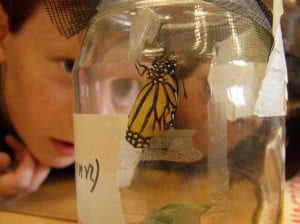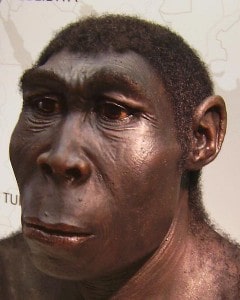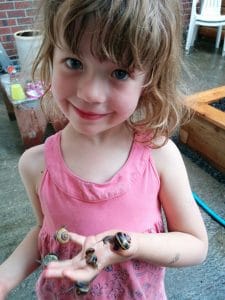Kids make great amateur scientists. They love to ask “why” questions. “Why is the monarch butterfly so colourful? Why does it start life as a caterpillar? Why does it migrate? Thanks to Charles Darwin, we now understand that questions such as these are entitled to an evidence-based answer – and it is the theory of evolution that provides the answer. To quote evolutionary biologist Theodosius Dobzhansky: “Nothing in biology makes sense except in the light of evolution.” Rather than taking away from the wonder of nature, understanding evolution only adds to it. There are so many mysteries in nature that we’ve not yet solved.
Children merit a truthful and passionate introduction to the natural world around them, especially if we are to harness their innate curiosity. Once children get a sense of how evolution works – and eventually link it to themselves – their eyes light up with wonder. I remember one little girl in grade 4 saying, “You mean we’re animals!” Without a basic understanding of evolution, nature study – and much of biology – risks becoming the memorization of species names and facts.
Unfortunately, there’s a perception among many parents and teachers that evolution is hard to explain, or that they’ll get something wrong. It’s really not that difficult at all. Conversations about evolution should be done in context. Allow the children to think the process through themselves. A discussion might go something like this. “Look at that animal over there. What is it? (a squirrel). Is a squirrel a bird, an insect or a mammal? (mammal). How do you know? (It has hair). Okay, well if we lived at the North Pole and we saw a squirrel, do you think it would have more or less hair? (more) Why? (to help it stay warm). So, if the weather here was to get colder and colder every year, what do you think would happen with the squirrels? (develop more hair). Well, you’re right, because there’s always a chance that when baby squirrels are born, some may have more hair than others. This will help these lucky ones to survive, find a mate and have babies. They don’t “try” to have more hair; it just happens by chance. Eventually, all of the squirrels may end up with more hair, since they might be the only ones to survive the colder weather.”
In a nutshell, evolution can be explained to children like this: 1. All creatures struggle to survive and have babies, but many fail. 2. Creatures born with a helpful trait (e.g., a longer bill) are more likely to survive and have babies. 3. Parents pass on the useful trait(s) to their young. 4. Over time, these new traits can lead to a new species – one that can only have babies with its own kind.
Human origins
Eventually, the question of human origin will come up. You might say something like this: “In Africa, there were once primates (e.g., monkeys, lemurs and apes) that were similar to modern day chimpanzees. They became separated into two groups. One continued to live in forests, spent a lot of time in trees and usually walked and climbed on all fours. The other group moved into more open fields and had to spend more time on the ground. Over time, the second group started acting differently like walking upright, which is better for seeing long distances above the grass. Over about seven million years (it takes about three days to count to a million, non-stop) the differences between the groups increased, until the second group became more or less like we are today, and the first group became chimpanzees. That’s what evolution is: if living things find themselves in a new environment- let’s say living in fields instead of forests – they change over time in order to survive. As for humans, we evolved to have big, smart brains in order to “think” our way to meeting our needs. For example, we began to build tools and to develop language. Scientists have found fossils of many of our human ancestors.” A great video to watch with children eight or older can be found by Googling “Khan academy + human evolution overview”.
If kids ask about explanations that don’t align with evolution, tell them not to accept what others say – even Mom and Dad – but to focus on evidence. This includes fossils, the amazing similarities in the fetuses and bodies of humans and all other vertebrates and the similarities in the genes, which you can explain as the recipes for making plants and animals. Tell them that when scientists look at chimpanzee genes, they are practically identical to those of human genes. We even share more than half our genes with bananas! Kids are great critical thinkers if you give them a chance.
Activities
1. Small changes: This activity shows how small changes over time make a big difference. Draw a simple bug on the first page of a stack of paper. Then pass the paper on to another person and have them draw the bug as exactly as they can. They should move the original to the bottom of the stack. Have them pass their copy onto the next person who will try to reproduce the bug. Don’t forget to hide the previous version under the stack. Do this at least ten times. Compare the original to the “evolved” bug. Was there much of a difference? All it takes is a small change (mutation) in each generation to create huge change over time. Think of how birds evolved from dinosaurs!
2. What’s bugging you? Here’s an interactive story about bugs, which can help young children understand the concept of evolution. “Let’s say I release 100 bugs onto a green lawn. Fifty are green and 50 are brown. Now, which bugs do you think will best be able to hide from enemies like bug-eating birds? (Most kids will say green ones.) So, if I go back in a few years, would I find more green or more brown bugs? (green again). And, what color will the babies of the green bugs be? (green). That’s right. Just as your mom or dad passed on a certain trait like your blue eyes, the parent green bugs will pass on the green color to their babies. (Now comes the tricky part.) Let’s say some green bugs that usually live on green lawns get blown in a storm to an island where there is mostly brown sand. Life will be hard. However, once in a rare while, a pair of these green bugs might produce a brown baby. This is because little mistakes sometimes happen in how an animal’s body makes a baby. Do you think those rare brown babies would escape enemies more easily? (yes). And, if the rare brown bugs live a little longer because they can hide better, do you think they may have more babies than the green bugs? (Most kids will agree.) What color would most of the babies be? (brown.)
As the years go by, brown bugs will become more and more common. Color isn’t the only thing that might change, however. Because a sandy habitat offers fewer places to hide, the babies that are born with other good traits for hiding — once again because of a mistake in how the parents’ body makes a baby — would end up surviving more easily. Such a trait might be bigger, stronger front legs that are good for digging hiding spots in the sand. Now, let’s say that hundreds of years later, there is another huge storm. Some of the brown bugs get blown off the island and end up on the grassy lawns where their ancestors came from. Would they have trouble surviving? (Kids should say, yes.) Well, that’s not the only problem they would have. Other than eating, what else do all animals do? (Prompt someone to say, “have babies.”) Well, imagine a male brown sand bug meets a female green lawn bug (or vice versa). She might just chase him away or completely ignore him. She won’t want to make babies with him because, being brown and having huge front legs, he looks so different. At this point, we can say that the green lawn bugs and the brown sand bugs have evolved into two different species. Just like horses and zebras!)
3. Paper circles game: This is a hands-on version of part of the story above. It shows how nature “decides” (natural selection) who survives and has babies. Using a whole punch, make 50 sand-brown and 50 grass-green paper circles. You might want to use paint sample cards. Sprinkle 20 of each colour on a green lawn. Give the children maybe 30 seconds to remove as many of the little circles as they can (but only one at a time). Then, count the number of circles of each colour that were picked up. For every circle that remains on the grass (20 minus number picked up), add 3 or so of the same colour. This represents reproduction. Repeat the activity for a couple of more “generations”. The children will see how the “population” on the lawn shifts towards the colours that are hardest to see. You can then try the same activity on sand.
Next week, I’ll provide more activities and thoughts on teaching evolution. What better way to celebrate Earth Day than helping kids understand the reason for our Earth’s huge diversity of life!


